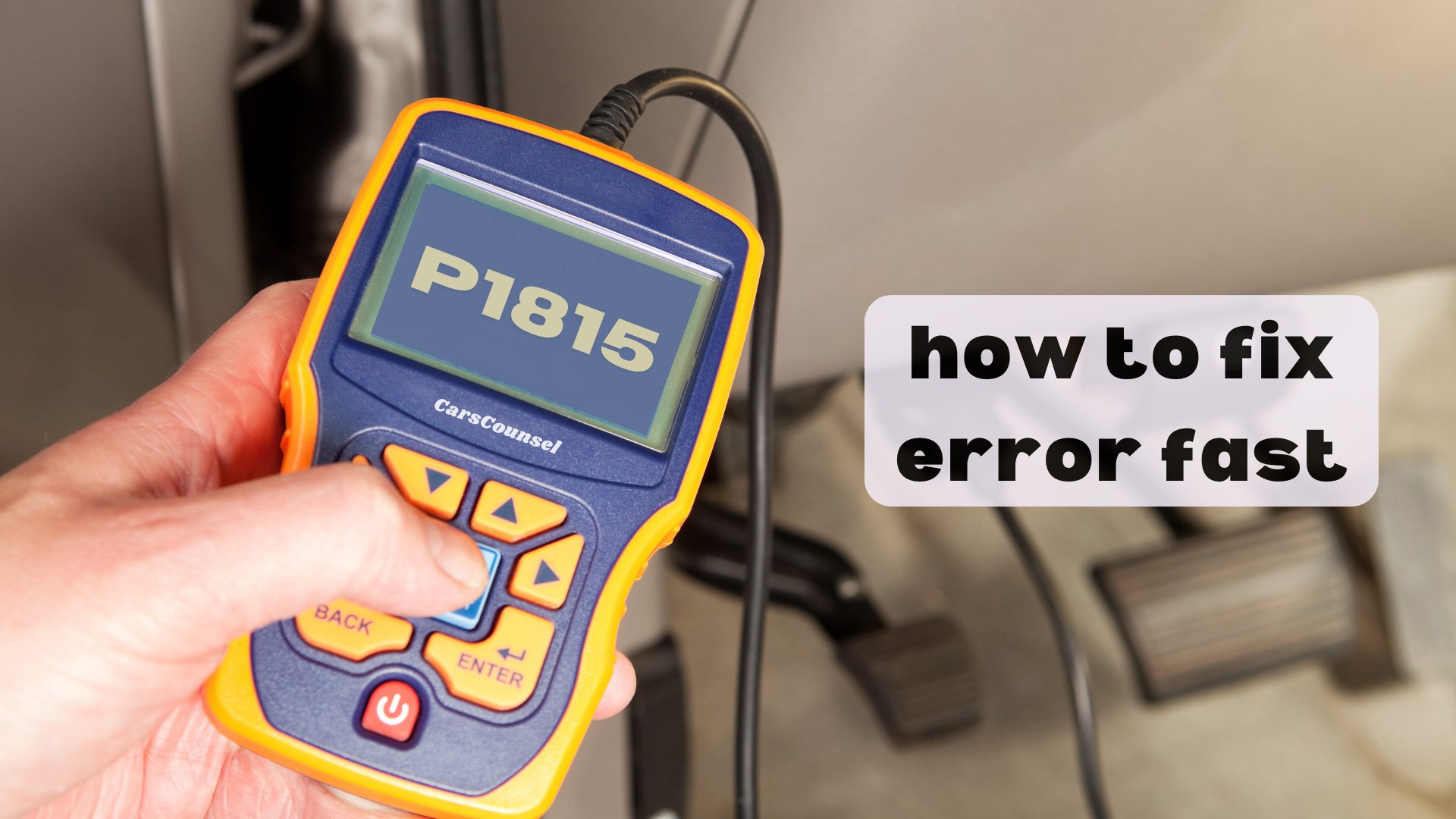Think of your car’s transmission as the heart of its drive, and a P1815 code is like an unsettling heartbeat you can’t ignore. You’re probably wondering how to fix this problem quickly.
First, use an OBD-II scanner to confirm the error code and find any related codes.
Next, check the transmission range selector switch and its wiring for any visible damage or rust. Also, make sure your transmission fluid levels are correct.
If the problem still isn’t fixed, you might need to look into possible ECM issues and regular maintenance tips.

Quick Navigation
Key Takeaways
- Use a code reader to confirm the P1815 error and find any related issues.
- Check and replace a broken transmission range selector switch right away.
- Look for and fix any damaged or rusty wiring connections.
- Make sure the transmission fluid is at the right level and is clean.
Understanding the P1815 Code
The P1815 code is a sign that there’s a problem with your car’s transmission range selector switch, which is important for your automatic transmission to work correctly.
When this code appears, it means the Engine Control Module (ECM) has found an issue with this switch. This can cause rough gear changes, slipping gears, and trouble shifting between park and drive.
To figure out what’s wrong, start by using an OBD-II scanner to check for Diagnostic Trouble Codes (DTCs). Confirm the problem with the transmission range selector switch, and look at the wiring for any damage or rust.
Proper diagnostics are key to making sure your gears shift smoothly and to prevent more transmission issues.
Common Causes of P1815
When dealing with the P1815 code, a bad transmission range selector switch is often the main problem.
Running detailed checks on the transmission can help you find and fix the issue. Damaged or corroded wiring can mess with how the car shifts gears, causing wrong signals to be sent to the car’s computer.
Also, if the transmission fluid is low, it can cause the transmission to act up, affecting the selector switch.
Although less common, problems with the car’s computer can also trigger this code due to software issues or internal faults.
Extreme temperatures and past incomplete repairs with cheap parts can also make things worse.
Address these potential causes one by one to ensure accurate and effective repairs.
Symptoms of P1815
If you see the P1815 code, you might find it hard to shift gears and hear strange noises when you try. These signs mean there are problems with your car’s gear system, which can make it tough to change gears, cause the engine to stall, or make the car hesitate when you press the gas. You might also notice warning lights on the dashboard and that your car uses more fuel than usual because the gears aren’t working right.
| Symptom | Cause | Resulting Issue |
|---|---|---|
| Hard to shift gears | Faulty transmission range selector | Improper gear engagement |
| Strange transmission noises | Damaged wiring or switch | Erratic shifting behavior |
| Dashboard warning lights | ECM detecting malfunction | Alert to potential transmission issue |
| Using more fuel than usual | Inadequate gear changes | Increased fuel consumption |
Spotting these problems early can help you avoid bigger issues with your car’s transmission.
Diagnosing the P1815 Code
To diagnose the P1815 code, start by using an OBD-II scanner to identify any trouble codes and confirm P1815 is present.
Then, examine the transmission range selector switch for any visible damage or wear.
Use a multimeter to check the wiring for any signs of damage or corrosion, and ensure all electrical connections are secure.
Also, check the transmission fluid levels and condition; low or dirty fluid can affect performance.
Finally, check the ECM (Engine Control Module) for any related codes and run necessary tests.
Transmission Range Selector Switch
The transmission range selector switch, often called the neutral safety switch, ensures that the correct gear is chosen and communicated to the engine control module (ECM).
To fix a P1815 error code, start by performing a thorough check of the transmission. You can find the switch near the transmission’s gear selector linkage. Look for any physical damage or signs of wear.
Use a multimeter to test the switch’s electrical output while shifting through the gears to make sure it’s sending the right signals to the ECM. If the switch isn’t sending accurate signals, replace it immediately to avoid more transmission problems.
After installing the new switch, repeat the diagnostics to ensure it works correctly. A properly functioning switch ensures smooth gear changes and reliable vehicle performance.
Wiring Issues and Solutions
When dealing with wiring problems related to the P1815 code, start by checking the wires connected to the transmission range selector switch for any damage or rust. This is crucial for figuring out wiring issues and fixing electrical problems.
Look for worn wires: Check for any signs of wear or exposed wires.
Check connectors: Make sure all connectors are secure and not rusty.
Test with a multimeter: Use a multimeter to check if the wires are working properly.
Replace bad wires: If you find damaged wires, change them out.
Secure the wires: Ensure the wiring harness is properly fastened to avoid future issues.
ECM Malfunctions
Every now and then, problems with the Engine Control Module (ECM) can cause the P1815 error code. To fix this, start by checking if the ECM needs a software update.
Car manufacturers often release updates to fix bugs that might cause wrong codes. Use a diagnostic scanner to find out if there’s an update available, and install it if there is.
If updating doesn’t solve the problem, look for internal issues in the ECM, like hardware failures or ongoing software problems. If you find any, you might need to reprogram or replace the ECM.
Make sure the ECM is properly calibrated to match your vehicle’s specs to avoid future issues and keep the transmission running smoothly.
Checking Transmission Fluid
After dealing with any possible ECM issues, check the transmission fluid to make sure the transmission is working right and to figure out the P1815 code correctly.
Do a detailed fluid check to spot any signs of contamination, which can mess up how the transmission works.
- Check Fluid Levels: Make sure the transmission fluid is at the right level.
- Look at Fluid Color: Good fluid is usually red or pink. Dark or burnt fluid means it’s contaminated.
- Smell the Fluid: A burnt smell could mean the fluid is overheated and contaminated.
- Check for Debris: Bits of particles or metal shavings in the fluid could mean there’s internal damage in the transmission.
Environmental Impact on Transmission
Extreme temperatures can really mess with your car’s transmission and lead to problems like the P1815 code.
When it’s too hot or too cold, the transmission fluid can change thickness, causing it to either not protect well enough or make it harder for the parts to move smoothly. Hot weather can make the fluid too thin, while cold weather can make it too thick.
These temperature changes also affect the electronic parts of your transmission. Wires can expand and contract, which might cause them to disconnect or short out. Seals and gaskets can also wear out faster, leading to leaks.
To avoid these issues, keep an eye on your transmission fluid and make sure all electrical connections are tight. Taking these steps can help keep your transmission running smoothly and prevent the P1815 code.
Preventive Maintenance Tips
To prevent problems like the P1815 code, regularly check and maintain your transmission system to keep it running smoothly. Doing routine inspections and regular maintenance can save you from expensive repairs and ensure everything works well.
Here are some simple maintenance tips to follow:
- Check Transmission Fluid: Regularly look at fluid levels and condition; replace it if it’s dirty or low.
- Inspect Wiring: Look for signs of wear or corrosion, and make sure all connections are secure.
- Test Transmission Range Selector Switch: Make sure it works properly by testing it from time to time.
- Monitor ECM/TCM Health: Use diagnostic tools to check that these modules are working correctly.
More OBD-II Codes
Frequently Asked Questions
Can a P1815 Code Affect the Vehicle’s Overall Performance?
Yes, a P1815 code can affect how well your vehicle’s transmission works. To fix this, you should scan for diagnostic trouble codes (DTCs), check the transmission range selector switch, and make sure the transmission fluid levels are correct.
Is It Safe to Drive With a P1815 Code?
It’s better to be safe than sorry. Driving with a P1815 code isn’t a good idea. This code means there could be problems with your transmission or gear shifts, which can make driving unsafe. Fix the issue right away to keep your car running well.
How Much Does It Typically Cost to Repair a P1815 Code?
Fixing a P1815 code can cost different amounts. You might pay between $50 and $100 for a diagnosis. Changing the transmission range selector switch could be $200 to $500. If there are wiring problems or issues with the ECM, the total cost could be higher.
Can a P1815 Code Cause Damage to Other Vehicle Systems?
You might think a P1815 code isn’t a big deal, but it can cause significant problems. This code can lead to rough shifting, engine stalling, and even damage to the drivetrain.
What Tools Are Needed to Diagnose a P1815 Code at Home?
To diagnose a P1815 code at home, you’ll need a diagnostic scanner to read the trouble codes, a multimeter to check the wiring, and a dipstick to check the transmission fluid level. Make sure all connections are tight and the fluids are clean.
Conclusion
To sum up, fixing the P1815 code isn’t as scary as it looks. Just follow these steps like a detective solving a mystery, and you’ll get it done quickly.
Use an OBD-II scanner, check the transmission range selector switch, inspect the wiring, make sure the fluid levels are right, and think about reprogramming the TCM if you need to.
Staying on top of maintenance will help you avoid future problems and keep your transmission running smoothly.
Remember, a little effort now can save you a lot of trouble later!

